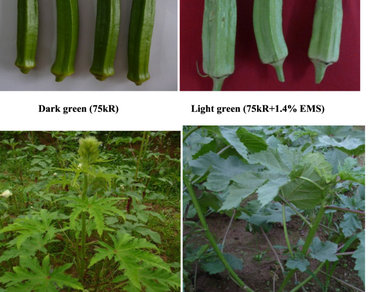Efficacy of mutagenic treatment with gamma-rays, EMS and combinations in producing superior mutants in okra (Abelmoschus esculentus L.)
Research Articles | Published: 17 May, 2022
First Page: 1078
Last Page: 1084
Views: 3454
Keywords: Abelmoschus esculentus, EMS, Gamma rays, Mutagenic effectiveness, Mutagenic efficiency
Abstract
Okra or lady’s finger (Abelmoschus esculentus (L.) Moench), also known as bhindi in India, belongs to the family Malvaceae. Broadening the genetic base through induced mutations is a supplementary tool that can lead to the development of genetic variability. The present experiment was undertaken to generate a broad genetic variability by determining mutagenic effectiveness and efficiency of gamma rays, EMS and their combinations in 526 lines of okra. The research was conducted in two generations namely M1 and M2 during 2014–2016 kharif season (May–September) at Experimental Farm, Department of Vegetable Science, Chaudhary Sarwan Kumar Himachal Pradesh Krishi Vishvavidyalaya, Palampur (Himachal Pradesh). The parent material, selfed seeds of P-8variety were irradiated with 65, 75 and 85 kR doses of gamma rays and 1.2, 1.4 and 1.6% concentrations of EMS. The seeds along with control were space planted for raising M1 generation. Each M1 plant was harvested separately and desirable M1 individual plant progeny rows were laid in augmented design for raising M2 generation. The effectiveness and efficiency of the mutagen used was assessed from the data on biological damage in M1 generation. In M1 generation, results showed a dose dependent retardation in biological parameters like seed germination and plant survival; 75kR and 1.4% was depicted as LD50 values for both gamma rays and EMS, respectively. In M2 generation, 1.2% EMS had highest effectiveness (0.0431) and efficiency (2.02). The mutants with short internodal length, more number of nodes per plant, dwarf plant height, branched and high yield were isolated in M2 generation.

References
Chatterjee A, Shukla S, Mishra BK, Rastogi A, Singh SP (2012) Induction of variability through mutagenesis in opium poppy (Papaver somniferum L.). Turkish J Agri Forestry 36:1–11
Dalve PD, Musmade AM, Patil RS, Bhalekar MN, Kute NS (2012) Selection for resistance to yellow vein mosaic virus disease of okra by induced mutation. Bioinfolet 9(4B):822–823
De Carvalho C, Cruz P, Da Fonseca M, Xavier-Filho L (2011) Antibacterial properties of the extract of Abelmoschus esculentus. Biotechnol Bioprocessing Eng 16(5):971–977
Drake JW, Charlesworth B, Charlesworth D, Crow JF (1998) Rates of spontaneous mutation. Genetics 148:1667–1686
Gaul H (1964) Mutation in plant breeding. Radiation Bot 2(1):12–16
Ghai TR, Singh M, Arora SK (2004) Induced variability for economic characters in okra (Abelmoschus esculentus (L.) Moench). J Res PAU 41(1):63–67
Jabeen N, Mirza B (2004) Ethyl methane sulphonate induces morphological mutations in Capsicum annuum. Int J Agri Biol 6(2):340–345
Kamble GC, Paril AS (2014) Comparative mutagenicity of EMS and gamma radiation in wild chickpea. Int J Sci Env Technol 3:166–180
Kashid NG, Salve US (2014) Effect of induced mutation on leaf morphological changes in okra (Abelmoschus esculentus L. Moench). Int J Recent Adv Multidisc Res 1(1):1–2
Konzak CF, Nilan RA, Wagner J, Foster RJ (1965) Efficient chemical mutagenesis. The use of induced mutation in plant breeding. Rad Bot 5:49–70
Kumar S, Natarajan M, Thamburaj S (1998) Effect of gamma rays on fruit and seed characters in bhendi. South Ind Hort 46(5&6):312–315
Kumar H, Singh R, Gupta V, Zutshi SK (2015) Performance of different germplasm, plant extracts and insecticides against Yellow Vein Mosaic of okra (OYVMV) under field conditions. Vegetos 28(1):31–37
Liu H, Zhang J (2021) The rate and molecular spectrum of mutation are selectively maintained in yeast. Nat Commun 12:4044. https://doi.org/10.1038/s41467-021-24364-6
Minocha JL, Arnason TJ (1962) Mutagenic effectiveness of ethyl methane sulphonate in barley. Nature 196:499
Muller H (1927) The production of mutations by X-rays. Proc Natl Acad Sci USA 14:714
NARP (1993) National Agricultural Research Project, Horticultural crops. vol. 3, July 1993. NARP, CSIR, Accra, Ghana
Okagaki RJ, Neffer MG, Wessler SR (1991) A deletion common to two independently derived waxy mutations of maize. Genetics 127:425–431
Oyenuga VA (1968) Nigerian foods and feeding-stuff: Their chemistry and nutritive value, 3rd edn. Ibadan University Press, Nigeria
Pathania A, Gupta SK (2015) Evaluation of okra germplasm against powdery mildew. Pl Dis Res 30(2):192–193
Sabitha V, Ramachandran S, Naveen KR, Panneerselvam K (2011) Antidiabetic and antihyperlipidemic potential of Abelmoschus esculentus(L.) Moench. in streptozotocin-induced diabetic rats. J Pharm Bioallied Sci 3:397–402
Sengkhamparn N, Bakx EJ, Verhoef R, Schols HA, Sajjaanantakul T, Voragen AGJ (2009) Okra pectin contains an unusual substitution of its rhamnosyl residues with acetyl and alpha-linked galactosyl groups. Carbohydrate Res 344(14):1842–1851
Sikder S, Biswas P, Hazra P, Akhtar S, Chattopadhyay A, Badigannavar AM, D’Souza SF (2013) Induction of mutation in tomato (Solanum lycopersicum L.) by gamma irradiation and EMS. Ind J Genet 73(4):392–399
Thombre MV, Deshmukh SU (2006) Isolation of genetic male sterile mutant in okra [Abelmoschus esculentus (L.) oench]. Ind J Genet Plant Breed 66(4):353–354
Tomoda M, Shimizu N, Gonda R, Kanari M, Yamada H, Hikino H (1989) Anticomplementary and hypoglycemic activity of okra and hibiscus mucilages. Carbohydrate Res 190(2):323–328
Van Harten AM (1998) Mutation breeding: theory and practical applications. Cambridge University Press, Cambridge
Vavilov NI (1951) The origin, variation, immunity and breeding of cultivated plants (Translated by S. K. Chestitee). Chronica Botonica 13:1–366
Vayssade M, Sengkhamparn N, Verhoef R, Delaigue C, Goundiam O, Vigneron P, Voragen AGJ, Schols HA, Nagel M (2010) Antiproliferative and proapoptotic actions of okra pectin on B16F10 melanoma cells. Phytotherapy Res 24:982–989
Velmurugan M, Rajamani K, Paramaguru K, Gnanam R, Kannan Bapu JR, Harisudan C, Hemalatha P (2010) In vitro mutation in horticultural crops– a review. Agricultural Rev 31:63–67
Wani AA (2009) Mutagenic effectiveness and efficiency of gamma rays, ethyl methane sulphonate and their combination treatments in chickpea (Cicer arietinum L.). Asian J Plant Sci 8:318–321
Author Information
Department of Vegetable Science and Floriculture, College of Agriculture, Chaudhary Sarwan Kumar Himachal Pradesh Krishi Vishvavidyalaya, Palampur, India